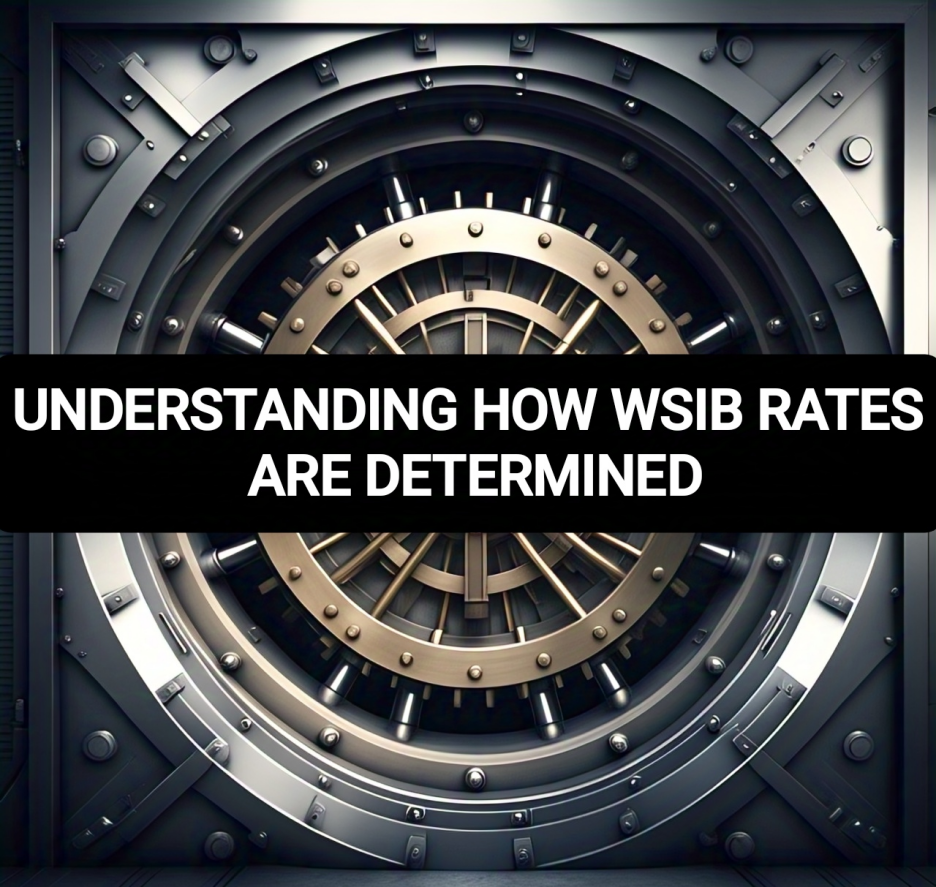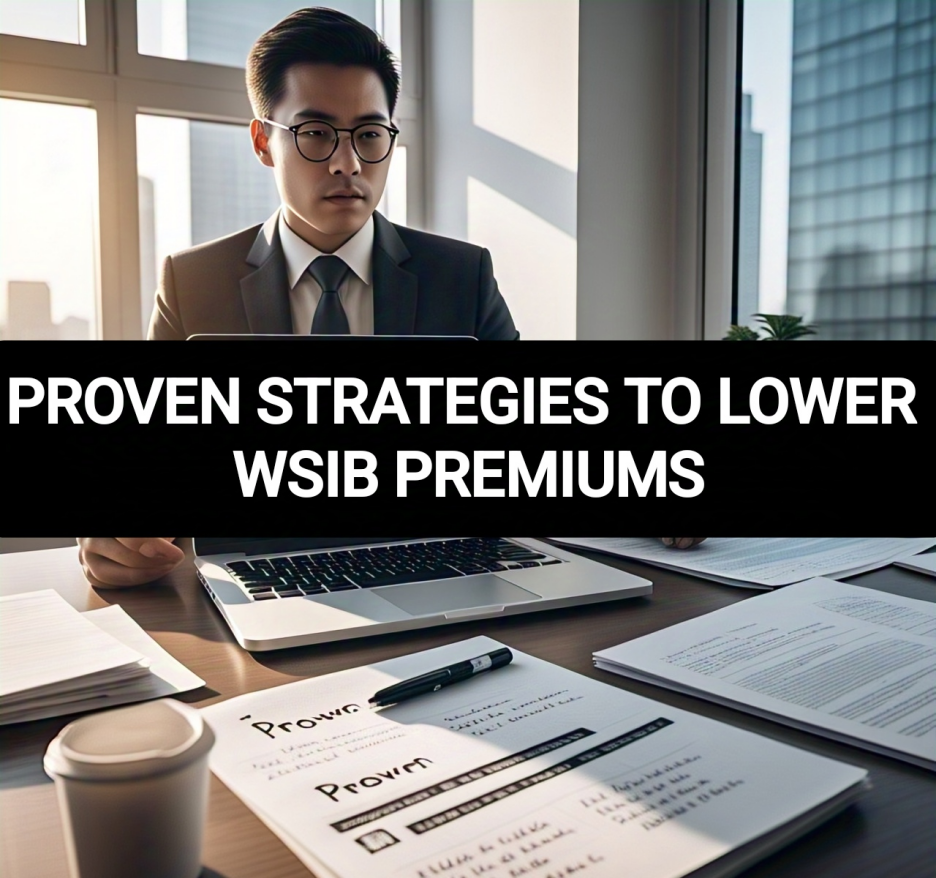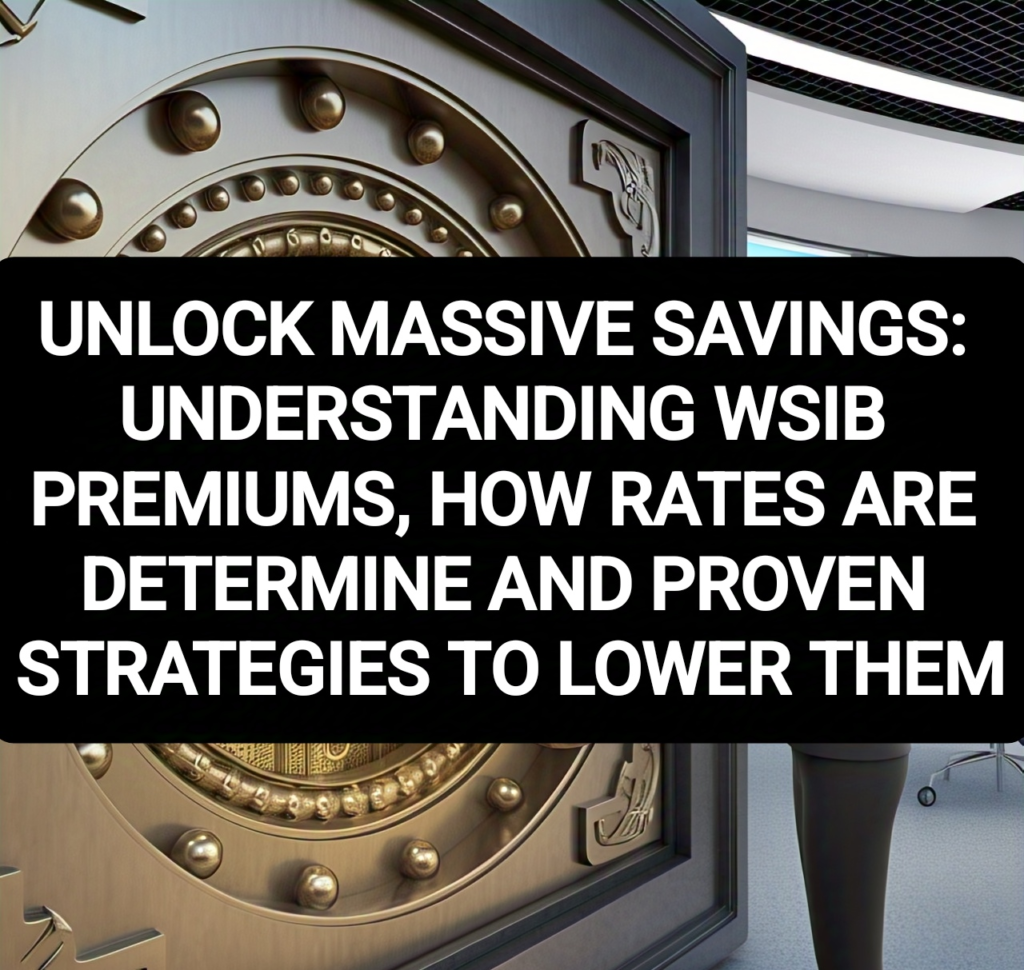UNLOCK MASSIVE SAVINGS: UNDERSTANDING WSIB PREMIUMS, HOW RATES ARE DETERMINED, AND PROVEN STRATEGIES TO LOWER THEM
INTRODUCTION TO WSIB PREMIUMS
Discover how to unlock massive savings on WSIB premiums with our expert guide.
As a business owner in Ontario, Canada, you’re likely familiar with the Workplace Safety and Insurance Board (WSIB) premiums. These premiums are a necessary expense for many businesses, but did you know that there are ways to lower them? In this article, we’ll explore how WSIB rates are determined, factors affecting WSIB premiums, and proven strategies to lower them. By the end of this article, you’ll be equipped with the knowledge to unlock massive savings on your WSIB premiums.
UNDERSTANDING HOW WSIB RATES ARE DETERMINED

WSIB rates are determined based on the industry and occupation of your business. The WSIB uses a rate classification system to determine the premium rate for each business. This system takes into account the level of risk associated with each industry and occupation. The higher the risk, the higher the premium rate.
The WSIB also uses a experience rating program to adjust premium rates based on a business’s claims history. If your business has a good claims history, you may be eligible for a lower premium rate. Conversely, if your business has a poor claims history, your premium rate may be higher.
TYPES OF WSIB PREMIUMS
The WSIB offers two primary types of premium structures for employers in Ontario:
1. Schedule 1 Premiums
Schedule 1 premiums are paid by employers who are classified under Schedule 1 of the WSIB’s Employer Classification Manual. This schedule includes most industries and businesses in Ontario, such as:
– Manufacturing and production
– Construction and trades
– Service industries (e.g., hospitality, healthcare)
– Retail and wholesale trade
Employers under Schedule 1 pay premiums based on their insurable earnings, which are calculated as a percentage of their payroll. The premium rates vary depending on the industry and occupation classification.
2. Schedule 2 Premiums
Schedule 2 premiums are paid by employers who are classified under Schedule 2, which typically includes:
– Government agencies
– Certain Crown corporations
– Other specified entities
Schedule 2 employers pay claim costs directly to the WSIB, rather than paying premiums based on insurable earnings. This approach allows Schedule 2 employers to manage their costs more directly and potentially reduce their expenses.
CALCULATION OF WSIB PREMIUMS
WSIB premiums are calculated based on the employer’s insurable earnings and premium rate. The formula is:
Premium = Insurable Earnings x Premium Rate ÷ 100
To calculate insurable earnings, employers need to determine their gross earnings, deduct non-insurable earnings, and apply the annual maximum insurable earnings limit.
HOW WSIB RATES ARE DETERMINED

The Workplace Safety and Insurance Board (WSIB) rate-setting process is a complex system that determines the premium rates employers in Ontario pay for workplace safety and insurance coverage. Understanding how WSIB rates are determined is crucial for businesses to manage their costs effectively and potentially lower their premium rates.
OVERVIEW OF THE WSIB RATE-SETTING PROCESS
The WSIB rate-setting process involves several key steps that determine the premium rates for employers in Ontario. The process is designed to ensure that premium rates accurately reflect the level of risk associated with each industry and business.
– Step 1: Industry Classification: The WSIB assigns a unique industry classification to each business based on its primary business activity. This classification determines the premium rate, as different industries have varying levels of risk associated with them. The WSIB uses the Employer Classification Manual to determine the industry classification for each business.
– Step 2: Rate Calculation: The WSIB calculates premium rates using a rolling six-year period, considering factors such as insurable earnings, claims count, and claims costs. The rate calculation takes into account the industry classification, claims history, and other factors that impact premium rates.
– Step 3: Experience Rating: The WSIB uses an experience rating system to adjust premium rates based on a business’s claims history. This system takes into account the number of claims, claim costs, and the business’s overall safety record. The experience rating program rewards businesses with good safety records and penalizes those with poor safety records.
– Step 4: Rate Setting: The WSIB sets premium rates annually, taking into account industry trends, business performance, and experience rating adjustments. The WSIB reviews and updates premium rates to ensure that they accurately reflect the level of risk associated with each industry and business.
FACTORS THAT INFLUENCE WSIB RATES
Several factors influence WSIB rates, including:
– Industry: Different industries have varying premium rates based on their level of risk. For example, industries with higher injury rates, such as construction, may have higher premium rates. The WSIB uses industry classification codes to determine the premium rate for each business.
– Occupation: The type of occupation or job duties also impact premium rates. For example, occupations with higher risk of injury, such as manual labor, may have higher premium rates. The WSIB considers the specific job duties and tasks performed by employees when determining premium rates.
– Claims History: A business’s claims history plays a significant role in determining its premium rate. Businesses with a higher number of claims or more severe claims may face higher premium rates. The WSIB reviews claims history over a rolling six-year period to determine the premium rate.
– Insurable Earnings: The total earnings of employees that are subject to WSIB premiums also impact premium rates. The WSIB uses insurable earnings to calculate premium rates, taking into account the industry classification, claims history, and other factors.
EXPLANATION OF THE EXPERIENCE RATING PROGRAM
The experience rating program is a key component of the WSIB rate-setting process. This program adjusts premium rates based on a business’s claims history and safety record. The experience rating program:
– Rewards Good Safety Records: Businesses with good safety records and low claims frequency may be eligible for lower premium rates. The experience rating program rewards businesses that demonstrate a commitment to workplace safety and health.
– Penalizes Poor Safety Records: Businesses with poor safety records and high claims frequency may face higher premium rates. The experience rating program penalizes businesses that fail to maintain a safe work environment and have a high number of claims.
– Encourages Safety Improvements: The experience rating program encourages businesses to implement effective safety programs and practices to reduce claims and improve their safety record. By providing incentives for good safety practices, the experience rating program promotes a culture of safety in the workplace.
The experience rating program uses a complex formula to calculate a business’s experience rating factor. This factor is based on the business’s claims history and safety record, and it adjusts the premium rate accordingly. By understanding how the experience rating program works, businesses can take proactive steps to manage their costs and potentially lower their premium rates.
FACTORS AFFECTING WSIB PREMIUMS

Understanding the factors that affect WSIB premiums is crucial for businesses to manage their costs effectively and potentially lower their premium rates. Here are the key factors that influence WSIB premiums:
1. Industry and Occupation Classification
The industry and occupation classification of a business plays a significant role in determining its WSIB premium rate. Different industries and occupations have varying levels of risk associated with them, and the WSIB assigns premium rates accordingly.
– Industry Risk Level: The WSIB assigns a risk level to each industry based on the level of risk associated with it. Industries with higher risk levels, such as construction or manufacturing, may have higher premium rates.
– Occupation Classification: The WSIB also considers the occupation classification of employees when determining premium rates. Occupations with higher risk levels, such as manual labor or heavy machinery operation, may have higher premium rates.
2. Claims History and Experience Rating
A business’s claims history and experience rating are also significant factors that affect WSIB premiums. Businesses with a higher number of claims or more severe claims may face higher premium rates.
– Claims Frequency: The number of claims filed against a business can impact its premium rate. Businesses with a higher claims frequency may face higher premium rates.
– Claims Severity: The cost of claims, including medical expenses and lost wage benefits, can also impact premium rates. Businesses with more severe claims may face higher premium rates.
– Experience Rating: The WSIB uses an experience rating system to adjust premium rates based on a business’s claims history and safety record. Businesses with good safety records and low claims frequency may be eligible for lower premium rates.
3. Payroll and Reporting Requirements
The payroll and reporting requirements of a business also impact WSIB premiums. Businesses must report their payroll information accurately to ensure correct premium calculations.
– Insurable Earnings: The WSIB calculates premium rates based on insurable earnings, which include gross earnings, including wages, salaries, and other forms of compensation.
– Reporting Requirements: Businesses must report their payroll information regularly, either monthly, quarterly, or annually, depending on their reporting frequency.
– Accurate Reporting: Accurate reporting is essential to ensure correct premium calculations. Businesses must ensure that their payroll information is accurate and up-to-date.
4. Safety Record and Workplace Health and Safety Practices
A business’s safety record and workplace health and safety practices are also significant factors that affect WSIB premiums. Businesses with good safety records and effective health and safety practices may be eligible for lower premium rates.
– Safety Programs: Businesses can implement safety programs to reduce workplace injuries and claims. Effective safety programs can help businesses identify and mitigate workplace hazards.
– Workplace Health and Safety Practices: Businesses can also implement workplace health and safety practices to promote a safe work environment. This can include regular safety training, hazard identification, and incident reporting.
– Safety Record: A business’s safety record is a significant factor in determining its premium rate. Businesses with good safety records may be eligible for lower premium rates.
By understanding the factors that affect WSIB premiums, businesses can take proactive steps to manage their costs and potentially lower their premium rates. This includes implementing effective safety programs, maintaining accurate records, and promoting workplace health and safety practices.
PROVEN STRATEGIES TO LOWER WSIB PREMIUMS

Here are some effective ways to manage WSIB premiums:
1. Implementing a Workplace Health and Safety Program
Implementing a workplace health and safety program is a crucial step in reducing WSIB premiums. A well-designed program can help identify and mitigate workplace hazards, reduce injuries, and promote a safe work environment.
– Hazard Identification and Risk Assessment: Regularly identify and assess workplace hazards to prevent injuries and illnesses.
– Safety Training and Education: Provide regular safety training and education to employees to ensure they understand workplace hazards and safe work practices.
– Workplace Inspections: Conduct regular workplace inspections to identify and address potential hazards.
– Incident Reporting and Investigation: Establish a process for reporting and investigating workplace incidents to identify root causes and implement corrective actions.
2. Reducing Claims through Effective Return-to-Work Programs
Effective return-to-work programs can help reduce WSIB claims and premiums. These programs provide support and accommodations to employees who have been injured or ill, enabling them to return to work safely and efficiently.
– Early Intervention: Implement early intervention strategies to support employees who have been injured or ill, including providing modified work duties or accommodations.
– Communication and Collaboration: Foster communication and collaboration between employees, supervisors, and healthcare providers to ensure a smooth return-to-work process.
– Accommodations and Modified Work: Provide accommodations and modified work duties to support employees who have been injured or ill, enabling them to return to work safely and efficiently.
3. Accurate Classification and Reporting
Accurate classification and reporting are essential to ensure correct WSIB premium calculations. Businesses must ensure that their industry classification and payroll reporting are accurate to avoid overpaying or underpaying premiums.
– Industry Classification: Ensure that the business’s industry classification is accurate and up-to-date to reflect the nature of the business.
– Payroll Reporting: Report payroll information accurately and regularly to ensure correct premium calculations.
– Record-Keeping: Maintain accurate and detailed records of workplace injuries, illnesses, and claims to support WSIB reporting and premium calculations.
4. Experience Rating and Premium Adjustments
Experience rating and premium adjustments can help businesses lower their WSIB premiums. Businesses with good safety records and low claims frequency may be eligible for lower premium rates.
– Experience Rating: The WSIB uses an experience rating system to adjust premium rates based on a business’s claims history and safety record.
– Premium Adjustments: Businesses with good safety records and low claims frequency may be eligible for premium adjustments, which can help lower WSIB premiums.
OTHER STRATEGIES TO LOWER WSIB PREMIUMS
In addition to implementing a workplace health and safety program, reducing claims through effective return-to-work programs, accurate classification and reporting, and experience rating and premium adjustments, businesses can also consider other strategies to lower WSIB premiums.
– Workplace Wellness Initiatives: Implement workplace wellness initiatives to promote employee health and well-being, reducing the risk of injuries and illnesses.
– Employee Training and Education: Provide regular employee training and education on workplace health and safety, including hazard identification and safe work practices.
– Workplace Ergonomics: Implement workplace ergonomics programs to reduce the risk of musculoskeletal injuries and promote employee comfort and well-being.
By implementing these proven strategies, businesses can lower their WSIB premiums, reduce costs, and promote a safe and healthy work environment.
BEST PRACTICES FOR MANAGING WSIB PREMIUMS

Implementing best practices, businesses can manage their WSIB premiums effectively and reduce costs. Here are some best practices for managing WSIB premiums:
1. Implement a Workplace Health and Safety Program
Implementing a workplace health and safety program is a crucial step in managing WSIB premiums. A well-designed program can help identify and mitigate workplace hazards, reduce injuries, and promote a safe work environment.
– Hazard Identification and Risk Assessment: Regularly identify and assess workplace hazards to prevent injuries and illnesses.
– Safety Training and Education: Provide regular safety training and education to employees to ensure they understand workplace hazards and safe work practices.
– Workplace Inspections: Conduct regular workplace inspections to identify and address potential hazards.
2. Maintain Accurate Records and Reporting
Maintaining accurate records and reporting is essential to ensure correct WSIB premium calculations. Businesses must ensure that their industry classification, payroll reporting, and claims reporting are accurate to avoid overpaying or underpaying premiums.
– Industry Classification: Ensure that the business’s industry classification is accurate and up-to-date to reflect the nature of the business.
– Payroll Reporting: Report payroll information accurately and regularly to ensure correct premium calculations.
– Claims Reporting: Report workplace injuries and illnesses accurately and promptly to ensure correct claims processing.
3. Implement Effective Return-to-Work Programs
Effective return-to-work programs can help reduce WSIB claims and premiums. These programs provide support and accommodations to employees who have been injured or ill, enabling them to return to work safely and efficiently.
– Early Intervention: Implement early intervention strategies to support employees who have been injured or ill, including providing modified work duties or accommodations.
– Communication and Collaboration: Foster communication and collaboration between employees, supervisors, and healthcare providers to ensure a smooth return-to-work process.
– Accommodations and Modified Work: Provide accommodations and modified work duties to support employees who have been injured or ill, enabling them to return to work safely and efficiently.
4. Monitor and Manage Claims
Monitoring and managing claims is essential to reduce WSIB premiums. Businesses must ensure that claims are reported accurately and promptly, and that claims are managed effectively to minimize costs.
– Claims Reporting: Report workplace injuries and illnesses accurately and promptly to ensure correct claims processing.
– Claims Management: Manage claims effectively by providing supporting documentation, communicating with WSIB, and ensuring that claims are resolved efficiently.
– Claims Analysis: Analyze claims data to identify trends and areas for improvement, and implement strategies to reduce claims and premiums.
5. Take Advantage of Experience Rating and Premium Adjustments
Experience rating and premium adjustments can help businesses lower their WSIB premiums. Businesses with good safety records and low claims frequency may be eligible for lower premium rates.
– Experience Rating: The WSIB uses an experience rating system to adjust premium rates based on a business’s claims history and safety record.
– Premium Adjustments: Businesses with good safety records and low claims frequency may be eligible for premium adjustments, which can help lower WSIB premiums.
By implementing these best practices, businesses can manage their WSIB premiums effectively, reduce costs, and promote a safe and healthy work environment.
THINGS TO AVOID WHEN MANAGING WSIB PREMIUMS

When managing WSIB premiums, there are several things to avoid, including:
1. Inaccurate Industry Classification
Inaccurate industry classification is a common mistake that can lead to incorrect premium rates. Businesses must ensure that their industry classification accurately reflects their business activities.
– Understand the Classification System: Familiarize yourself with the WSIB’s classification system and ensure that your business is classified correctly.
– Review and Update Classification: Regularly review and update your industry classification to reflect any changes in your business activities.
2. Incorrect Payroll Reporting
Incorrect payroll reporting is another common mistake that can lead to incorrect premium calculations. Businesses must ensure that their payroll reporting is accurate and up-to-date.
– Understand Insurable Earnings: Familiarize yourself with the WSIB’s definition of insurable earnings and ensure that your payroll reporting accurately reflects these earnings.
– Regularly Review Payroll Reporting: Regularly review your payroll reporting to ensure that it is accurate and up-to-date.
3. Failure to Report Claims Promptly
Failure to report claims promptly is a common mistake that can lead to increased costs and unnecessary stress. Businesses must ensure that claims are reported promptly and accurately.
– Understand Reporting Requirements: Familiarize yourself with the WSIB’s reporting requirements and ensure that claims are reported promptly and accurately.
– Establish a Reporting Process: Establish a process for reporting claims promptly and accurately, and ensure that all employees understand the process.
4. Poor Claims Management
Poor claims management is a common mistake that can lead to increased costs and unnecessary stress. Businesses must ensure that claims are managed effectively to minimize costs.
– Understand Claims Management: Familiarize yourself with the WSIB’s claims management process and ensure that claims are managed effectively.
– Assign a Claims Manager: Assign a claims manager to oversee the claims process and ensure that claims are managed effectively.
5. Failure to Implement Effective Safety Programs
Failure to implement effective safety programs is a common mistake that can lead to increased WSIB premiums. Businesses must ensure that they have effective safety programs in place to prevent workplace injuries and illnesses.
– Develop a Safety Program: Develop a safety program that identifies and mitigates workplace hazards, and provides training and education to employees.
– Regularly Review and Update Safety Program: Regularly review and update your safety program to ensure that it is effective and up-to-date.
FREQUENTLY ASKED QUESTIONS
Q1: What are WSIB premiums?
A: WSIB premiums are payments made by employers in Ontario to fund workplace safety and insurance benefits for workers who are injured on the job.
Q2: How are WSIB premium rates determined?
A: WSIB premium rates are determined based on the industry classification, claims history, and experience rating of a business.
Q3: What is experience rating?
A: Experience rating is a system used by the WSIB to adjust premium rates based on a business’s claims history and safety record.
Q4: How can I lower my WSIB premiums?
A: Businesses can lower their WSIB premiums by implementing effective safety programs, maintaining accurate records, and participating in experience rating programs.
Q5: What is the benefit of implementing a safety program?
A: Implementing a safety program can help reduce workplace injuries and illnesses, which can lead to lower WSIB premiums and improved productivity.
Q6: How do I know if my business is classified correctly?
A: Businesses can review their industry classification with the WSIB to ensure that it accurately reflects their business activities.
Q7: Can I appeal my WSIB premium rate?
A: Yes, businesses can appeal their WSIB premium rate if they believe it is incorrect.
Q8: How can I get more information about WSIB premiums?
A: Businesses can contact the WSIB directly or consult with a WSIB expert to get more information about WSIB premiums and how to lower them.
Q9: What are some common mistakes to avoid when managing WSIB premiums?
A: Common mistakes to avoid include inaccurate industry classification, incorrect payroll reporting, and failure to report claims promptly.
Q10: How can I stay up-to-date with WSIB premium rates and regulations?
A: Businesses can stay up-to-date with WSIB premium rates and regulations by regularly reviewing the WSIB website, attending workshops or seminars, and consulting with a WSIB expert.
CONCLUSION
In conclusion, understanding WSIB premiums and how rates are determined is crucial for businesses in Ontario to manage their costs effectively. By implementing proven strategies to lower WSIB premiums, businesses can unlock massive savings and improve their bottom line.
TAKE ACTION TODAY
Don’t let WSIB premiums drain your business’s resources. Take action today to:
– Understand Your Industry Classification: Ensure that your business is classified correctly to avoid overpaying premiums.
– Implement Effective Safety Programs: Develop a safety program that identifies and mitigates workplace hazards, and provides training and education to employees.
– Maintain Accurate Records: Keep accurate records of workplace injuries and illnesses, and ensure that claims are reported promptly and accurately.
– Take Advantage of Experience Rating: Participate in experience rating programs to potentially lower your WSIB premiums.
GET STARTED NOW
By following the strategies outlined in this guide, businesses can unlock massive savings and improve their bottom line. Get started now and take control of your WSIB premiums. Review your current WSIB premiums, identify areas for improvement, and implement the strategies outlined in this guide to start saving today.
MAXIMIZE YOUR SAVINGS
Don’t miss out on the opportunity to maximize your savings. By understanding WSIB premiums and implementing proven strategies to lower them, businesses can reduce their costs and improve their competitiveness. Take action today and start unlocking massive savings.
ADDITIONAL RESOURCES
How To Report And Pay Your Premiums: https://www.wsib.ca/en/businesses/premiums-and-payment/how-report-and-pay-your-premiums
Premium And Payment Frequently Asked Questions: https://www.wsib.ca/en/businesses/premiums-and-payment/premiums-and-payment-faqs
ABOUT AUTHOR
Shanel John is a dedicated Certified Public Accountant (CPA) at G.L.H. Accounting, specializing in Income Tax with 10 years of experience. Based in Brampton, Ontario, Canada, Shanel offers expertise in tax preparation, financial accounting, and advisory services. A certified QBO Pro Advisor, Shanel’s decade-long experience and knowledge make her a trusted figure in the accounting field.

